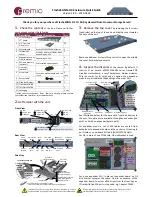
25. Spanning Tree
ROX™ v2.2 User Guide
242
RuggedBackbone™ RX5000
3.
Identify edge ports
Ports that connect to host computers, IEDs and controllers may be set to edge ports in order to
guarantee rapid transitioning to forwarding as well as to reduce the number of topology change
notifications in the network.
4.
Choose the root bridge.
The root bridge can be selected to equalize either the number of bridges, number of stations or
amount of traffic on either of its legs. It is important to realize that the ring will always be broken in
one spot and that traffic always flows through the root.
5.
Assign bridge priorities to the ring.
The strategy that should be used is to assign each bridge’s priority to correspond to its distance
from the root bridge. If the root bridge is assigned the lowest priority of 0, the bridges on either side
should use a priority of 4096 and the next bridges 8192 and so on. As there are 16 levels of bridge
priority available, this method provides for up to 31 bridges in the ring.
6.
Implement the network and test under load.
25.3.3. RSTP Port Redundancy
Figure 25.5. Port Redundancy
In cases where port redundancy is essential, RSTP allows more than one bridge port to service a LAN.
For example, if port 3 is designated to carry the network traffic of LAN A, port 4 will block. Should an
interface failure occur on port 3, port 4 would assume control of the LAN.
25.4. Spanning Tree Configuration
The Spanning Tree menu is accessible from the main menu under switch. The path to this menu is
switch/spanning-tree. The RSTP Common Instanc, Spanning Tree Parameter form and eRSTP form
appear on the same screen as the Spanning Tree menu.
















































